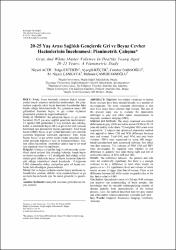20-25 yaş arası sağlıklı gençlerde gri ve beyaz cevher hacimlerinin incelenmesi: Planimetrik çalışma

View/
Access
info:eu-repo/semantics/openAccessDate
2008-05Author
Acer, NiyaziErtekin, Tolga
Küçük, Ayşegül
Babaoğlu, Cumhur
Çankaya, M. Niyazi
Çamurdanoğlu, Mehmet
Metadata
Show full item recordAbstract
Amaç: İnsan beyninde cinsiyete ilişkin varyasyonlar
birçok araştırıcı tarafından incelenmiştir. Bu çalışmaların çoğunda erkek beyin hacminin bayanlardan daha
büyük olduğu bildirilmektedir. Bu çalışmanın amacı MR
görüntüleri üzerinde beyaz ve gri cevher ölçümleri
planimterik yöntem ile değerlendirmektir.
Gereç ve Yöntemler: Bu çalışmada beyaz ve gri cevher
hacimleri 20-25 yaş arası sağlıklı gençlerde incelenmiştir.
T2 ağırlıklı MR görüntüleri 12 kişi üzerinde elde edilmiş,
kadın ve erkeklerde beyaz (BC) ve gri cevher (GC) oranını
belirlemek için planimetrik ölçüm yapılmıştır. Total beyin
hacmi (TBH), beyaz ve gri cevher hacimleri yarı otomatik
yazılımla bilgisayar üzerinden yapılmıştır. Total beyin
hacmi, beyaz ve gri cevher hacim ölçüm sonuçları cinsiyetler
arasında bağımsız t testi ile karşılaştırılmıştır. Tahmin
edilen hacimlerin istatistiksel analizi sağ ve sol taraf
için unpaired t testi ile yapılmıştır.
Bulgular: Cinsiyet ve taraflar (sağ ve sol) arasında istatistiksel
olarak anlamlı fark olmadığı bulundu. Ancak beyaz
cevherler açısından α = 0.1 alındığında fark olduğu ve kadınlara
göre erkeklerde beyaz cevherin hacminin daha bü-
yük olduğu istatistiksel olarak kanıtlandı. P-değerinin
0.085 olmasından dolayı cinsiyetlere göre sol beyaz cevherde
fark olmadığını göstermektedir.
Sonuç: Gri ve beyaz cevherin oranları beyin atrofisini anlamada
bize yardımcı olabilir. Aynı zamanda beyaz ve gri
cevherin hacim hesabı için bu metot güvenilir ve geçerlidir. Objective: Sex-related variations in human
brain structure have been studied broadly in a number of
investigations. The most consistent observation is that
men have larger brain volumes than women. The aim of
the present study was to evaluate the planimetric
technique to gray and white matter measurements in
magnetic resonance imaging (MRI).
Material and Methods: The study examined sex-related
differences in gray (GM) and white matter (WM) in 20–25
year old healthy individuals. T2-weighted MRI scans were
acquired in 12 subjects and optimized planimetry method
was applied to detect GM and WM difference between
men and women. Total GM, total WM, and total brain
volumes (TBV) were segmented by using MR image–
based computerized semi automated software. Sex effect
was then assessed. The volumes of WM, GM and TBV
were investigated by unpaired t-test whether or not
difference in genders’ two sides being right and left of
estimated volumes of WM, GM and TBV.
Results: The difference between the genders and side
were not statistically significant, but there is a enough
evidence to be a difference in total white matter on
genders at α = 0.1 significance level and volume of white
matter on man is bigger than that of women. There is not
difference between left white matter on genders due to the
fact that p-value is 0.085.
Conclusion: Quantitative ratios of GM and WM volumes
can improve our understanding of brain atrophy; this
knowledge may be valuable indistinguishing atrophy of
disease patterns from characteristics of the normal
process. Also, the method described here for gray matter
and white matter volume calculation is reliable and valid.
Source
Afyon Kocatepe Üniversitesi, Kocatepe Tıp DergisiVolume
9Issue
1Collections
- Makaleler [452]


















